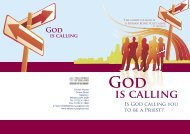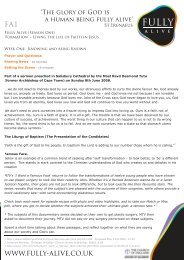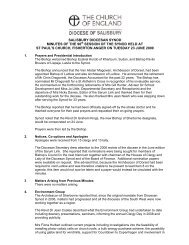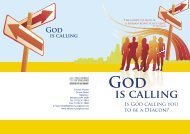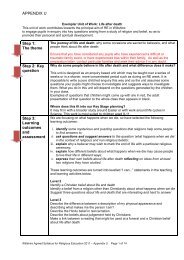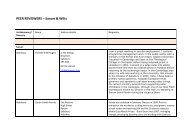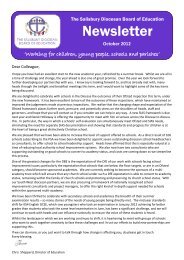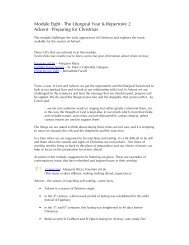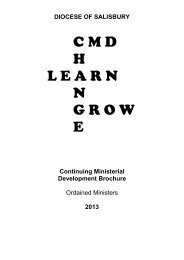I Can Statements
I Can Statements
I Can Statements
Create successful ePaper yourself
Turn your PDF publications into a flip-book with our unique Google optimized e-Paper software.
Appendix FI <strong>Can</strong>…A Wiltshire SACRE tool for using the 8 level scale of expectations in RERE Today © 2011The 8 level scale of Expectations of Standardsin RE from the QCDA / CCFS (originally in theNational Framework for RE, 2004) can beused to generate ‘I can’ statements for pupils.Here are some examples covering levels 1-8,which teachers across the key stages mayfind useful.They are only examples, and teachers will seehow they might be adapted to differentcurriculum content or age groups and todifferent religions. Teachers should seek togenerate their own ‘I can…’ statements. Thelanguage here is designed to be more ‘pupilfriendly’ than the scale itself, which is aprofessional tool for teachers. But you may yetwish to simplify it further for display on theclassroom wall, or in conversation withclasses about ‘what we’re looking for in RE’,or in peer and self assessment activity.The first set in each box relate to AT1,learning about religion (in plain text).The second set relate to AT 2, learning fromreligion (in italics).It is not possible to be comprehensive ingiving ‘I can…’ statements for all aspects ofa syllabus: each teacher does things theirway. So these are partial, but are included inSACRE’s guidance to support the AgreedSyllabus. They refer closely to the fields ofenquiry, themes, questions, experiences,knowledge, skills, attitudes andunderstanding in each of key stages 1-3which the Wiltshire RE Syllabus prescribes.Building the bridge from the 8 level scale tothe classroom is part of the teacher’s task.This will take you more than half way, butyour own school will show the rest of theway. These are written to imply a learningactivity very clearly, and as such may notconnect with the way any individual schoolapproaches the programme of RE work.They are an illustration of good practice.NoteIt cannot be overemphasised that these arejust examples but they are intended to showhow the generalised, dense language of the8 level scale actually translates into specificcontent and tasks. Here we build specificsonto the general foundation of the scale.Teachers will take a unit from the syllabus andwrite some ‘I can…’ statements which put thelearning targets into pupil friendly speech. Thisis easier than it might look, but usually needs tobe drafted and redrafted.As always, the teacher’s judgement about thebest fit of a level to a piece of work is central.The scale is just as useful in setting tasks andexpectations as it is in weighing up what pupilshave achieved ~ maybe more so.Good ‘I can…’ statements use the skillwords at the heart of the scale, sharpenthem against the content the pupils havestudied, and use simple, clear language tosay exactly what is required for the level tobe achieved.Wiltshire Agreed Syllabus for Religious Education 2011 – Appendix F Page 1 of 11
Name, recall, recognise,talk aboutLevel 1 Level 1 Level 1 Level 1I can…AT1Name…Recall (stories)Recognise… (symbols)• Name a church or a synagogue from a picture• Remember and tell someone three things that happened in thestory of Mary and Joseph at Christmas.• Recognise the Torah and the Bible as examples of holy books• Say what happened to the Baby Moses after he was left in thebulrushes.• Put six pictures from the Divali story in the right order.• From six artefacts or photos, pick three that are associated withChristians, or three that are used in a Synagogue.• Talk about a 7 branched candlestick: where would you see this,and what does it stand for to Jews?• Say why a rainbow is a good sign in the Noah story• Name two festivals that Christians like to celebrate.• Name some people in the Easter stories and recognise how theyfelt in the stories• Name some Easter artefacts• Say what I liked in the story of Saint Francis• Recall the outline of the story from Genesis 1AT2Talk about...• Talk about what I find interesting or puzzling about creation• Talk about a favourite person in the story of Christmas, Id orHanukkah• Talk about a happy celebration and a sad occasion.• Say what I think is good about sharing things fairly.• Say what makes unfair shares a bad idea.• Talk about thanking and being thanked, praising and beingpraised.• Talk about things that matter most in my bedroom, and thingsthat matter most in a Synagogue or a Church.• Talk about how it feels to create something myself, and how itwould feel to have your creation spoiled• I can talk about caring for the earth and identify actions thatshow care for the planet.• Talk about belonging: who do I belong to? How does it show?Do some people belong to God?• Talk about how symbols of light make me feel.• Speak about my own celebrations and someone else’scelebrations.• Talk about a special time of celebration and say why it is worthcelebrating• Talk about how an objects might help someone remember theEaster story• Talk about the difference being Jewish makes in family life.• Talk about my own ideas about what makes a book, or a day,or a building special, precious or holy.Wiltshire Agreed Syllabus for Religious Education 2011 – Appendix F Page 2 of 11
Retell, respond sensitivelyLevel 2 Level 2 Level 2 Level 2I <strong>Can</strong>…AT1:Show awareness (of similarities)Identify (how religion is expressed)…Suggest meanings…(symbols, stories)Begin to recognise (importance)• Put 7 parts of the creation story into the right order (sequencing)• Use some religious words (like creation, creator, God) to explainwhy Christians might love the earth• Match up some Christian beliefs with some Christian symbolsand artefacts (e.g. linking the Cross to Easter).• Retell a story of Jesus, and suggest a meaning the story mighthave for a Christian person.• Use a saying of Jesus as a title and theme to a story made up byme, which is about children of my own age (e.g. ‘Love YourNeighbour’ or ‘Do Not Worry’).• Suggest two things that matter to a Christian, to a Jewish personor to a Muslim.• Suggest three things that matter most to a Christian when theyare remembering Easter.• Identify a religious belief (e.g. Jewish, Christian or Muslim).• Say what makes the Torah Scroll and the Gospel special orsacred and to whom.• Give a reason why Jewish people like to go to Synagogue.• Identify a Christian hero and suggest the meaning of a storyabout her/him• Suggest what the lesson of Jesus’ Parable of the Pearl might be.• Suggest what the story of Hanukkah or of Pesach could mean fora Jewish family today.• Gather and select from pieces of information about a religiousfestival, ceremony or act of worship.AT 2Respond sensitively…Ask questions…Recognise… (own values, others values)• Respond sensitively to stories about people from (e.g.) theJewish and Christian religions, noticing what matters to them.• Ask questions about created things, made by humans or innature• Respond sensitively to the ideas and questions that comefrom the story of Genesis 1• Recognise that some ways of behaving might spoil the earth.• Talk about saying sorry and forgiving people: why does itmatter?• Respond imaginatively to stories of kindness, self sacrifice orbravery from sacred texts with my own ideas.• Ask some questions about creation and its puzzling mysteries:e.g. give two answers to: ‘does a beautiful world mean there’sa wonderful God?’• Make up some good questions to ask ‘the person who knowseverything’ / God.• Suggest three questions about God that are interesting andhard to answer.• Suggest some things that are precious, though money can’tbuy them• Discuss or write down a reaction to a story with an angel in it:talk about what the angel stands for.• Recognise – talk about – how we use all our senses tocelebrate a big day• Talk about how a piece of music can express a feeling like joyor excitement, and how singing together (including in worship)makes people feel.Wiltshire Agreed Syllabus for Religious Education 2011 – Appendix F Page 3 of 11
Describe, make linksLevel 3 Level 3 Level 3 Level 3I <strong>Can</strong>…AT1Describe… Make links...Begin to identify the impact…Recognise similarities and differences…Use a developing religious vocabulary…• Describe three things Christians believe in, and say whatdifference the beliefs make at Christmas.• Describe the importance of two main Muslim beliefs, and sayhow they are shown on the Pilgrimage to Makkah.• Investigate a question such as: what difference does worshipmake to everyday life?• Describe some symbols of belonging that Hindus and Christiansuse when they worship.• Make a link between how a Bible story is used in Church, andhow it may have an impact on a Christian child.• Make a link between a piece of Christian music and a Bible textwhich inspired it.• Investigate, recognise and describe three similarities betweenDivali and Easter.• List four differences between worship in a Mandir and aSynagogue• Make links between Gandhi’s beliefs and the way he chose tolive his life• Describe what inspired Archbishop Oscar Romero to speak outagainst injustice• Describe why a Christian might choose to forgive someone• Identify similarities and differences between the people studiedand their actions and beliefs• Make a link between two Muslim artefacts (e.g. Qur’an stand andprayer mat) and the fast during Ramadan.• Make a link between Hindu vegetarianism and the idea thatdivine life is in every living creature.• Answer the question ‘what is the purpose of a sacred place?’referring to examples from 2 religions studied, using generalwords like ‘worship’ ‘community’ and ‘belong’AT2Reflect on experiences… Identify influences…Ask religious questions… Make links…Compare responses...• Ask questions and investigate answers on why worshipperschoose to attend Mosque, Mandir, Synagogue or Church.• Ask some questions and suggest some answers about howthe Bible influences Christians, and what influences me.• Write my reflections on a Hindu value like harmlessness/vegetarian diet: how would my school change if we all livedby this value?• Suggest some things people do to find peace, stillness andrest (including practices of worship), and some things I do.• Suggest answers Christians and Muslims might give toquestions about their practice of giving to charity at Christmas(e.g. Christian Aid) and Zakat (giving charity or alms to thepoor in Islam).• Prepare a reflection on the ways Hajj matters in Islam andResurrection matters at Easter in Christianity, making a link towhat matters to me.• Make a link between religious leaders who I have studied andthe kind of person I like to ‘follow’. Compare my answerthoughtfully with someone else’s answer.• Investigate why no one ever needs to leave Sikh worshipfeeling hungry, and consider their own ideas about generosity.• Make a link between my own values about animals and theidea of God as creator of the world.• Describe something that inspires me to behave in a particularway• Identify a person inspires me and how my actions might beinspired by their exampleWiltshire Agreed Syllabus for Religious Education 2011 – Appendix F Page 4 of 11
Show understanding, use religious vocabulary, apply ideas, describe influencesLevel 4 Level 4 Level 4 Level 4I <strong>Can</strong>…AT1Describe similarities and differences…Make links between… Describe the impact of religion…Use religious vocabulary to show understanding…• Show that I understand how the parable of the Good Samaritancan have an impact on Christians today.• Use the right words to show that I understand why a pilgrimage isdifferent from a holiday.• Describe what pilgrims hope for on their way to Makkah / Iona.• Show my understanding of two differences between Muslims,Christians and Hindus, and two of the ways these religions aresimilar.• Describe and link up Christian beliefs with Christian behaviour,eg belief in God as creator linked to ‘green’ practice.• Use the right words to show that I understand three ways inwhich Muslim worship shows devotion to Allah• Show my understanding of what it means to belong to Sikhism bydescribing how Amrit feels to a Sikh person of my age.• Describe two different marriage services used in Christiancommunities, saying what is similar and different between them.• Describe Communion for Christians; puja for Hindus; Fridayprayers for Muslims; or prayers in the gurdwara and say why itmatters so much for believers• Use the right words to describe my understanding of four of theMuslim ’99 Names’ of Allah.• Connect up the work of Christian Aid with three sayings of Jesusabout poverty.• Explain how different beliefs about what happens when we diemay cause people to live their life in different ways.• Describe how two contemporary religious leaders have inspiredtheir followers to make a difference in their community.• describe the impact of some of Gandhi’s principles and showhow his words can be used to address contemporary situationsAT2Suggest answers to questions…Describe what inspires / influencesRefer to religions… Apply ideas to their own lives…Show my understanding…• Devise four good questions about what makes a leader worthfollowing, and state what a Sikh might say about GuruNanak’s leadership.• Suggest some answers to ‘why’ questions about Jesus,Bishop Desmond Tutu and Jackie Pullinger, who were willingto practice self sacrifice.• Apply the idea of self sacrifice to my own actions thoughtfully.• Refer to the teaching of Bible or Qur’an to describe howMartin Luther King or Malcolm X were inspired by their faith towork for racial equality.• Describe what I would be inspired to speak out against, or bestirred to act against, and why that particular issue isimportant to me• Refer to Sikh sources or quotations in giving my ownresponse to Sikh belief about God.• Refer to Sikh teaching about Langar and Sewa in describingmy vision of an inspiring community.• Create a statement of my own beliefs about God, life afterdeath or human values referring to ideas from two religionsI’ve studied and / or from agnostic and atheist writing.• Refer to the teachings of the 2 religions to show that Iunderstand how calligraphy expresses some Muslim spiritualideas, and crucifix paintings express some Christian ideas.• Describe something I find spiritual and inspiring in a poem,painting or design.• Apply three sayings of Jesus or the Buddha to my own life,giving my reaction to the religious teaching.• Gather, select and organise information about Buddhist,Christian and Hindu responses to suffering and evil.• Is TV news biased against religion? Examine a story in thenews that features religion and apply ideas like ‘bias’ and‘fairness’ to the reporting of the story.Wiltshire Agreed Syllabus for Religious Education 2011 – Appendix F Page 5 of 11
Explain why, explain similar and different, express views, relate religion to lifeLevel 5 Level 5 Level 5 Level 5I <strong>Can</strong>…AT1Explain the impact…Describe why…Suggest reasons…Recognise diversity…Use a widening religious vocabulary….• Explain how Christians and Sikhs share some similar ideas aboutGod, recognizing that they are different too.• Suggest lines of enquiry that enable me to explain somedifferences the Five Pillars make to Muslim life individually, andin the community of the Ummah.• Explain the impact, for a Sikh and a Christian, of believing thatGod made humans all equally valuable.• Explain the impacts of the ways Christian Aid and Islamic Reliefput religious teaching into action in a world of poverty.• Enquire into and explain two reasons each for the authority givento the Guru Granth Sahib, the Bible or the Qur’an for a Sikh, aChristian and a Muslim.• Use language about prayer and meditation to suggest threereasons why Buddhists and Christians spend time in silence andstillness, and enquire into the differences between the practice ineach religion.• Recognize something unique in each of four religions, usingappropriate terminology.• Recognize two things that make a Quaker, a Roman Catholic, aBaptist and an Anglican distinctive within Christianity.• Explain what it means for a Jew or Christian to take Genesis 1-3literally, or to read it as a symbolic text.• Suggest three reasons why some scientists see religion as aproblem, but others see it as a partner.AT2Pose and suggest answers to questions… Express views…Relate questions and answers to my own life… Explaininfluences…• Contribute to discussions about what two Christian leaderssay about peace and conflict, relating the ideas to my own lifeand to conflict in the wider world.• Explain what Muslims and Christians see as the purposes oflife, expressing my own views about identity.• Relate the idea that God may be encountered / heard / felt inthe worship of Church or mosque, to my own ideas aboutmusic, stillness and communal reflection.• Explain two things that have influenced my views on the factthat 380 people own half the world’s wealth.• Explain two influences that sometimes make people tell lies,and two influences that encourage truthfulness.• Give an informed response to a question about the destiny ofthe soul after death, referring to teaching from two religions.• Express my own beliefs about life after death reflecting onideas from at least two religions I have studied.• Express views that refer to two religions on the fact that thetwenty richest people in the world own more money than thepoorest 48 nations.• Connect my own views about spiritual and religious questionswith a point of view I disagree with, explaining in an informedway some differences between respect and intolerance.• Consider whether examples of religion in the news usestereotypes about religious people, and give my views onwhether these stereotypes are harmful or unfair.• Explain how an issue which is addressed by Buddhism andChristianity is relevant to their own life.Wiltshire Agreed Syllabus for Religious Education 2011 – Appendix F Page 6 of 11
Interpret, give reasons for diversity, express insight, consider challengesLevel 6 Level 6 Level 6 Level 6I <strong>Can</strong>…AT1Interpret… Give informed accounts…Explain (impacts, reasons for diversity)…• Give an informed account of what is difficult or challenging aboutbeing a young Christian or Hindu in Britain today.• Interpret a silent video clip of a Bar Mitzvah and a Confirmation,explaining what the rituals mean in Jewish and Christiancommunities, by devising a commentary for the scene.• Explain the impact and diversity of Islamic and Sikh dress andfood ‘laws’ in Britain.• Interpret the general idea of belonging to a religion with referenceto rituals and commitments in Christian and Sikh practice.• Distinguish between two different Christian views about whypeople suffer, giving an informed account of Christianperspectives.• Give your interpretation of some ways Jews, Muslims andChristians describe the divine, God or Allah in words and in art(eg creeds, scripture, the decoration of Synagogues, Mosquesand Churches, music).• Interpret what two scientists (e.g. an atheist and a Christian)believe about how the universe began and how human lifeevolved; account for their disagreement.• Interpret and evaluate a range of sources, texts and authoritiesexploring the nature of life after death from different traditions.• Explain how one religion began and developed through andbeyond the life of its ‘founder’.• Give persuasive arguments to support their view about Nirvana,Heaven and Paradise, referring to Buddhist, Christian andIslamic teachings.AT2Express insights (using reasoning and examples)…Evaluate… Consider challenges…• Express an insight into ways that young people today mightbe inspired by Martin Luther King and / or Malcolm X.• Consider the ideas of Sikhs and Christians about rebirth andabout eternal life, responding to these ideas with reasonedarguments of my own.• Express my own thoughtful responses to the Holocaust andarticulate my views about the nature and causes of evil• Express my insight into promises made at weddings withreference to the vows of a Christian wedding and the Lavanused in Sikh marriage.• Express arguments and ideas about the value of meditation orprayer, showing a reasoned understanding of a religiousviewpoint I don’t agree with.• Comment respectfully on two opposite viewpoints about acontemporary moral issue, drawing out reasoned ideas aboutthe views I hold myself.• Consider the challenges posed by what I think are thestrengths and weaknesses of Muslim ideas about justice andcrime.• Consider the challenges of what an atheist, agnostic or theistmight say about God, then express my own insights into thequestion.• Evaluate two arguments that link belief in God to the origins ofthe universe and the natural world, expressing my insight intothe strengths and weakness that I see in the arguments.Wiltshire Agreed Syllabus for Religious Education 2011 – Appendix F Page 7 of 11
Account for, articulate personaland critical responsesLevel 7 Level 7 Level 7 Level 7I <strong>Can</strong>…AT1Show coherent understanding… Analyse…Account for influences (religion, history, culture)…Begin to evaluate critically…• Analyse two views of Christian leaders about dealing withterrorism in the light of varied examples of the Bible’s teaching onconflict.• Account for the influence of the Bible on two examples ofcontemporary uses of music and art in Christian worship.• Use varied examples of Buddhist and Christian art works to showa coherent understanding of stories from the founding of thetradition.• Account for some of the different ways Christians react to divorcein the light of Jesus’ teaching in the Gospels on forgiveness andon sexuality.• Begin to evaluate critically Islamic influences for justice in SouthAfrica in the light of the example of the Prophet Muhammad’s(PBUH) example and teaching.• Analyse some ways Christians and Sikhs in the UK today bringup the younger generation, using the concepts of secularisationand community cohesion.• Use figurative and symbolic language (e.g. incarnation,supremacy, above, Lord, uniqueness) to analyse how Christiansand Muslims speak of God / Allah.• Use the language of religious studies (e.g. transcendence,immanence) to account for differences between the Islamic andChristian understandings and language.• Use abstract concepts and general ideas to analyse examples ofbias from religion in the news.• Analyse two different examples of the Christian beliefs aboutGod as creator in the light of contemporary science.AT2Articulate personal and critical responses…Evaluate using evidence and examples…• Evaluate some reasons that converts give to explain why theyjoined their religion, using evidence and examples andresponding with my own ideas.• Use evidence and examples to weigh up theist and atheistideas about where humans come from, explaining why I holdmy own views in depth.• Use evidence and examples to show what might challenge anatheist and a theist.• Articulate 3 criticisms of a British Muslims stance on pacifismand violence.• Articulate 3 criticisms of the Church of England’s teachingabout sex, marriage and divorce.• Articulate 3 criticisms of atheist ideas of ‘morality without God’• Use evidence and examples to weigh up strengths andweaknesses of the view that keeping the Ten Commandmentswould improve British society today.• ‘Humanism isn’t a religion, so shouldn’t be studied in RE’Articulate personal and critical responses to this idea.• Use evidence and examples to evaluate how Christians andMuslims make their moral decisions, referring to specificteaching in sacred texts and specific issues about money,generosity and the pricelessness of life.• Apply arguments and religious ideas about women’s andmen’s roles in society to 2 case studies of sexism in theworkplace or in a religious setting.• Handle effectively evaluative questions about racism and thechallenge of equality to and from Christianity: In what ways isChristianity an anti racist religion?• Evaluate accounts of evil from Christianity, Islam, psychologyand horror movies, suggesting how my own insights about evilrelate to each of these sources or systems of belief.Wiltshire Agreed Syllabus for Religious Education 2011 – Appendix F Page 8 of 11
Analyse, contextualise, justify my viewsLevel 8 Level 8 Level 8 Level 8I <strong>Can</strong>…AT1Analyse and contextualise interpretations…Critically evaluate… Interpret and evaluate…• Analyse and contextualise some ways in which Christians roottheir environmental action in scripture and ideas of God ascreator and sustainer of life.• Analyse and contextualise some Muslim viewpoints on law andsociety in the UK in the light of Qur’anic teaching on ShariahLaw.• Give a critical and evaluative account of some examples of Sikhcommunity life in Southall, Swindon and Amritsar referring tosocial and religious factors in the ways these communities havedeveloped.• Account for the use of metaphorical language in the way somesacred texts (Mool Mantar, Apostle’s Creed, 1 st Surah of the HolyQur’an) speak of the divine.• Give an analytical account of why some people pray daily, andothers never, in the light of experiences, evidence andarguments about answered prayer and unanswered prayer.• Analyse two opposing interpretations of the Bible’s teachingabout divorce and remarriage in the gospels, accounting for thedivergent views of the issue found among Quakers, Methodistsand Catholics.• Analyse the statement ‘theodicy is impossible after Auschwitz.’Critically evaluate the idea.• Research independently and account for the continuingpopularity of Christmas in a secularising and pluralizing UnitedKingdom, using varied interpretations of the evidence.• Distinguish between the ways sociology of religion and Christiantheology might respond to the Census figures about religiousbelonging.• Draw balanced conclusions about selected examples of howreligion is portrayed in film and television.AT2Give independent, well informed and reasoned insights…Analyse in depth…Draw well substantiated and balanced conclusions…• Argue in an informed way the case for my own values aboutusing intoxicants, with reference to examples from MethodistChristianity and British Islam.• Analyse why six religions that all preach peace are involved inover 100 civil and international conflicts in the world today.• Use religious concepts from Sikhism to explain arguments forand against the reality of God, drawing balanced and wellsubstantiated conclusions.• Give well informed and insightful explanations of why interreligious understanding can make peace making betweencommunities easier.• Draw independent, well balanced and informed conclusions toa debate about God and astrophysics.• Analyse the idea of a free floating non-religious spirituality foryoung people in Britain today, in the light of the prevalentattitude that ‘religion is irrelevant, but spirituality is vibrant’:• Argue my own independent answer to the question: ‘can yoube committed to a spirituality without a tradition or acommunity?’• Conclude in a well informed way how people in two religionsmight influence my own ideas about responding to sufferingand evil.• Give a well informed insight into Christian and / or Muslimviews about the priority of marriage over any other context forfamily life and sexual fulfilment, and argue my own reaction.• Use my analysis of stories of answered prayer andunanswered prayer to draw a balanced conclusion to a studyof prayer that refers to psychology and theology.Wiltshire Agreed Syllabus for Religious Education 2011 – Appendix F Page 9 of 11
Good teaching will share the appropriate skills with pupils and make explicit opportunities, through well designed learning opportunities for pupils toacquire, practise and develop these central skills in RE.AT1 Learning about religion and beliefAT2 Learning from religion and belief8 Analyse and contextualise… Synthesise and justify their views7Account for, show coherentunderstanding...Evaluate critically and personally…6 Interpret… Express insights…5Explain (why, similarities anddifferences)…Express their views (in the light ofreligious teaching)…4 Show understanding… Apply ideas…3 Describe… Make links…2 Identify, Retell…Recognise, respondsensitively...1 Recall, Name… Talk about...Wiltshire Agreed Syllabus for Religious Education 2011 – Appendix F Page 11 of 11




